Study of a New Quick-Charging Strategy for Electric Vehicles in Highway Charging Stations
Abstract
:1. Introduction
- A new quick-charging strategy for multiple types of EVs with different battery sizes at a highway CS (where vehicle inflow is excessive) is proposed for the first time, which is summarised as follows: on the premise of not affecting the EVs being charged, the remaining power in the quick-charging pile with multiple power output interfaces is used to provide synchronous charging services for EVs waiting in the queue. This can reduce EV user waiting time, charging time, and dwell time, but can also improve the utilisation rate of charging infrastructure and service capacity of CS and reduce the queue length at the CS. At the same time, this can reduce the effects on the power grid.
- A solution for analysis and verification of the new quick-charging strategy is proposed, including the power distribution models for charging, the established queuing model of CS according to statistics of multi-type gasoline vehicles on Jiangsu highway, and the improved queuing algorithm, which can provide an important basis for the simulation.
2. New Quick-Charging Strategy and Power Distribution Model
2.1. Average Power Distribution Model
2.2. On-Demand Power Distribution Model
3. Queuing Model for Charging Station (CS)
3.1. Model of Pause Ratio for Electric Vehicles (EVs) on Highways
3.2. Model of Daily Station Inflow
3.3. Model of Arrival Time for EVs
3.4. Model of Waiting Time for EVs
3.5. Model of Charging Time for EVs
3.6. Utilisation Ratios of Charging Facilities of CS
4. Improved Queuing Algorithm (IQA)
- Step 1
- Initialise the system’s operating cycle, time step, entrance list (where the vector of the arrival customer in each line includes five variables such as the progress, duration and load in charging, arriving, and waiting times of the EV), arrival list, charging pile lists, departure list, and the maximum number of charging piles. Generate the arrival time of EVs entering the CS in the system’s operating cycle by using related data and Equations (5) to (8), and add it to the entrance list. Set the values of other variables to 0.
- Step 2
- Assess statistics from the EV entrance list and judge if there are any EVs entering the CS at that moment. If so, judge the charging type of EV users according to Equation (15) and proceed to Step (2.a); otherwise, do Step (2.b). Step (2.a): if the type of the EV user is a forced charging EV user, set the state of his/her EV to its arriving state, add one to the queue length including charging EVs, and put the EV into the arrival list and delete it from the entrance list. Otherwise, judge if there are any idle parking spaces in the CS; if not, let the adjustable EV user leave the CS, and delete it from the entrance list; if so, set the state of his/her EV to its arriving state, add one to the queue length including charging EVs, and put the EV on the arrival list and delete it from the entrance list. Step (2.b): analyse the statistics of the current EV arrival list and judge if there are any EVs in the arrival list; if there are any, the arrival list should be sorted in ascending order in accordance with the EV arrival times.
- Step 3
- Judge if there are any EVs in each charging pile list; if there are, successively calculate actual charging time of every EV according to Equations (10)–(13), but do not update the charging time. At the same time, calculate and record the waiting time of any EVs yet to be allocated power. All charging pile lists should be in ascending order in accordance with the waiting time of EVs to be allocated power.
- Step 4
- Judge if the number of EVs in the arrival list is bigger than the total number of charging piles; if so, allocate the arrival state EVs to charging piles in batches. Calculate and record the waiting time of those EVs to be allocated. At the same time, all charging pile lists should be sorted in ascending order in accordance with the waiting time of EVs yet to be allocated; otherwise, directly allocate the arrival state EVs to charging piles in order.
- Step 5
- Judge if there are any EVs in the charging pile lists; if not, set the number of charging state EVs to 0, the queue length to 0, and the charging load to 0. Judge if there are no EVs in any of the charging pile lists; if there are, turn to Step 8; otherwise, turn to Step 6.
- Step 6
- Set the number of charging state EV of each charging pile list to one, and add one to its charging progress. At the same time, set the state of remaining EVs as being in the waiting state, calculate the queue length, and allocate power to the charging state EVs and waiting state EVs in accordance with the on-demand or average power distribution method. In addition, according to Equations (10)–(13), update the state of charge of the EVs in charging and waiting states as well as the charging time of waiting state EVs.
- Step 7
- Judge if the charging progress of each EV, in each charging pile list, is one; if so, calculate its waiting time according to Equation (9) and set its state to charging state. Judge if the current charging state EV has completed its charging process; if so, delete it from the charging pile list, set its state as departing, and put it onto the departure list.
- Step 8
- Add the queue lengths of all charging pile lists as the station queue length. Add the charging power of all charging pile lists as the station charging load. The utilisation rate of charging infrastructure of the CS can be calculated according to Equation (14).
- Step 9
- Add one time step to the current analysis and judge if the result is smaller than the service period; if so, turn to Step 2, otherwise, end the program and output the result.
5. Numerical Simulation
5.1. Parameter Settings
5.1.1. Daily Traffic Flow Data and Probability Distribution of EVs on Highway
5.1.2. Parameter Settings of EVs
5.1.3. Parameter Settings of CS
5.2. Results and Analysis
5.2.1. Effects of Different Charging Situations on EVs
5.2.2. Effects of Different Charging Situations on CS
5.2.3. Effects of Different Charging Situations on the Power Grid
6. Conclusions
- For EV users, in terms of saving waiting time, charging time, and dwell time for EVs in a CS, NQCS is more efficient than conventional quick-charging (CQCS) and NQCSO is more efficient than NQCSA. NQCS utilises the controlled characteristics of waiting EVs, charges them appropriately, and effectively shortens the charging time by using chargers with multiple power output interfaces. In this way, the waiting time of the next EV is reduced and thus the charging time and dwell time are also effectively reduced, improving user satisfaction and the charging efficiency of the CS.
- For a CS, in terms of improving the utilisation ratio of charging facilities and the number of EVs served, and reducing the queue length at the CS, NQCS is more efficient than CQCS, and NQCSO is more efficient than NQCSA. NQCS effectively utilises the distributable power of each charging pile, not only meeting the charge requirements of EVs in progress, but also simultaneously allocating the rest of their available power to waiting EVs, thus improving the utilisation ratio of charging facility. In addition, the service provided at the CS is better due to great improvement in its charge efficiency, which can avoid the situation where more adjustable charging users leave the CS.
- For the power grid, in terms of reducing fluctuations of charging load on the CS, NQCS is more efficient than CQCS, and NQCSO is more efficient than NQCSA. NQCS fills the power coast-down of EVs in progress under variable power, but also solves the problem of charge diversity under constant power caused by capacity variations. Hence, the fluctuations of charging load of CS can be effectively reduced and requirements imposed upon the adjustability of the grid are lower, thereby decreasing the overall effect from then on.
Acknowledgments
Author Contributions
Conflicts of Interest
References
- Williams, J.H.; DeBenedictis, A.; Ghanadan, R.; Mahone, A.; Moore, J.; Morrow, W.R.; Price, S.; Torn, M.S. The technology path to deep greenhouse gas emissions cuts by 2050: The pivotal role of electricity. Science 2012, 335, 53–59. [Google Scholar] [CrossRef] [PubMed]
- Graditi, G.; Langella, G.; Laterza, C.; Valenti, M. Conventional and Electric Vehicles: A Complete Economic and Environmental Comparison. In Proceedings of the 2015 International Conference on Clean Electrical Power (ICCEP), Taormina, Italy, 16–18 June 2015.
- Ghamami, M.; Zockaie, A.; Nie, Y.M. A general corridor model for designing plug-in electric vehicle charging infrastructure to support intercity travel. Transp. Res. Part C 2016, 68, 389–402. [Google Scholar] [CrossRef]
- Morrissey, P.; Weldon, P.; O’Mahony, M. Future standard and fast charging infrastructure planning: An analysis of electric vehicle charging behavior. Energy Policy 2016, 89, 257–270. [Google Scholar] [CrossRef]
- Wang, S.; Crosier, R.; Chu, Y. Investigating the power architectures and circuit topologies for megawatt superfast electric vehicle charging stations with enhanced grid support functionality. In Proceedings of the 2012 IEEE International Electric Vehicle Conference (IEVC), Greenville, SC, USA, 4–8 March 2012.
- Zhao, G.; Huang, X.; Qiang, H. Coordinated control of PV generation and EVs charging based on improved DECell algorithm. Int. J. Photoenergy 2015. [Google Scholar] [CrossRef]
- Sun, B.; Dragičević, T.; Freijedo, F.D.; Vasquez, J.C.; Guerrero, J.M. A Control Algorithm for Electric Vehicle Fast Charging Stations Equipped with Flywheel Energy Storage Systems. IEEE Trans. Power Electr. 2016, 31, 6674–6685. [Google Scholar] [CrossRef]
- Anseán, D.; Dubarry, M.; Devie, A.; Liaw, B.Y.; García, V.M.; Viera, J.C.; González, M. Fast charging technique for high power LiFePO4 batteries: A mechanistic analysis of aging. J. Power Sources 2016, 321, 201–209. [Google Scholar] [CrossRef]
- Flores, R.J.; Shaffer, B.P.; Brouwer, J. Electricity costs for an electric vehicle fueling station with Level 3 charging. Appl. Energy 2016, 169, 813–830. [Google Scholar] [CrossRef]
- Aziz, M.; Oda, T.; Ito, M. Battery-assisted charging system for simultaneous charging of electric vehicles. Energy 2016, 100, 82–90. [Google Scholar] [CrossRef]
- Fotouhi, A.; Auger, D.J.; Propp, K.; Longo, S.; Wild, M. A review on electric vehicle battery modeling: From Lithium-ion toward Lithium-Sulphur. Renew. Sustain. Energy Rev. 2016, 56, 1008–1021. [Google Scholar] [CrossRef]
- Arora, S.; Shen, W.; Kapoor, A. Review of mechanical design and strategic placement technique of a robust battery pack for electric vehicles. Renew. Sustain. Energy Rev. 2016, 60, 1319–1331. [Google Scholar] [CrossRef]
- Yang, Y.; Zhang, W.; Niu, L.; Jiang, J. Coordinated charging strategy for electric taxis in temporal and spatial scale. Energies 2015, 8, 1256–1272. [Google Scholar] [CrossRef]
- Pu, Y. A matching problem and an existence with optimum algorithm. J. Chongqing Univ. 2014, 2, 62–68. (In Chinese) [Google Scholar]
- Yan, Y.; Luo, Y.; Zhu, T.; Li, K. Optimal charging route recommendation method based on transportation and distribution information. Proc. CSEE 2015, 35, 310–318. (In Chinese) [Google Scholar]
- Yang, S.N.; Cheng, W.H.; Hsu, Y.C.; Gan, C.H.; Lin, Y.B. Charge scheduling of electric vehicles in highways. Math. Comput. Model. 2013, 57, 2873–2882. [Google Scholar] [CrossRef]
- Chen, L.; Chen, Z.; Huang, X.; Jin, L. A Study on price-based charging strategy for electric vehicles on expressways. Energies 2016, 9, 385. [Google Scholar] [CrossRef]
- Bodet, C.; Jablonowski, R.; Erickson, K.; Schülke, A. An optimal local charging strategy for competing electric vehicles on quick charging facilities. In Proceedings of the 2012 3rd IEEE PES International Conference and Exhibition on Innovative Smart Grid Technologies (ISGT Europe), Washington, DC, USA, 14–17 October 2012.
- Hu, H. A Study on Charging Power Control Strategy for Electric Vehicles at Charging Station. Master’s Thesis, University of Electronic Science and Technology of China, Chengdu, China, 2011. [Google Scholar]
- Ding, H.; Hu, Z.; Song, Y. Value of the energy storage system in an electric bus fast charging station. Appl. Energy 2015, 157, 630–639. [Google Scholar] [CrossRef]
- Xiao, Z. Analysis of construction of charging pile for electric vehicles. In Construction Materials and Decoration; Kitchen Sanitary Facilities Industry Association in Chengdu: Chengdu, China, 2015. (In Chinese) [Google Scholar]
- Kong, J.; Hong, J. Planning and Design of Service Area on Expressways; China Building Materials Press: Beijing, China, 2009; pp. 110–111. (In Chinese) [Google Scholar]
- Ji, J.; Chen, H. A study on calculation model and analysis for service area’s scale. J. Highway Transp. Res. Dev. 2006, 10, 171–173. (In Chinese) [Google Scholar]
- Ma, R.; Ye, L.; Qin, Z. Daily load random fuzzy modeling of highway electric vehicle charging stations. J. Changsha Univ. Sci. Technol. 2015, 12, 81–88. [Google Scholar]
- Fan, C.; Li, H.; Jia, J.; Hao, L. The relationships among waiting time, perceived economic loss and service satisfaction: A study of taxi drivers’ waiting for gas. Manag. Rev. 2014, 11, 99–105. [Google Scholar]
- Google’s Official Website. Expressways of Changzhou in Jiangsu. Available online: http://www.google.cn/maps/ (accessed on 18 February 2016).
- Shi, K. Jiangsu Traffic Yearbook; Editorial office of Jiangsu Traffic Yearbook: Jiangsu, China, 2014; pp. 418–419. (In Chinese) [Google Scholar]
- Guo, X. Highway Traffic Operation Analysis: Methods and Application; Southeast University Press: Nanjing, China, 2012. [Google Scholar]
- Sun, R.; Hu, B.; Wang, J. Forecast of Traffic Flow, Toll Income, and Cost of Operation Maintenance in Xiyi Highway, First-Grade Highway, and Huan-Taihu Highway; Jiangsu-Weixin Engineering Consultants Inc.: Nanjing, China, 2014. (In Chinese) [Google Scholar]
- Hao, H.; Wang, H.; Ouyang, M. Prediction of China’s passenger vehicle and commercial vehicle stocks. J. Tsinghua Univ. Sci. Technol. 2011, 6, 868–872. (In Chinese) [Google Scholar]
- Tan, X.; Zhao, H.; Peng, H.; Li, D. Quasi-real-time coordinated charging/discharging policy for electric vehicles. Trans. China Electrotech. Soc. 2015, 13, 69–76. (In Chinese) [Google Scholar]
- Tesla’s Official Website in China. Available online: https://www.tesla.cn/supercharger/ (accessed on 1 February 2016).
- Yan, Z. Value Assessment Research of Battery Energy Storage in Smart Grid. Master’s Thesis, Shanghai Jiaotong University, Shanghai, China, 2012. [Google Scholar]
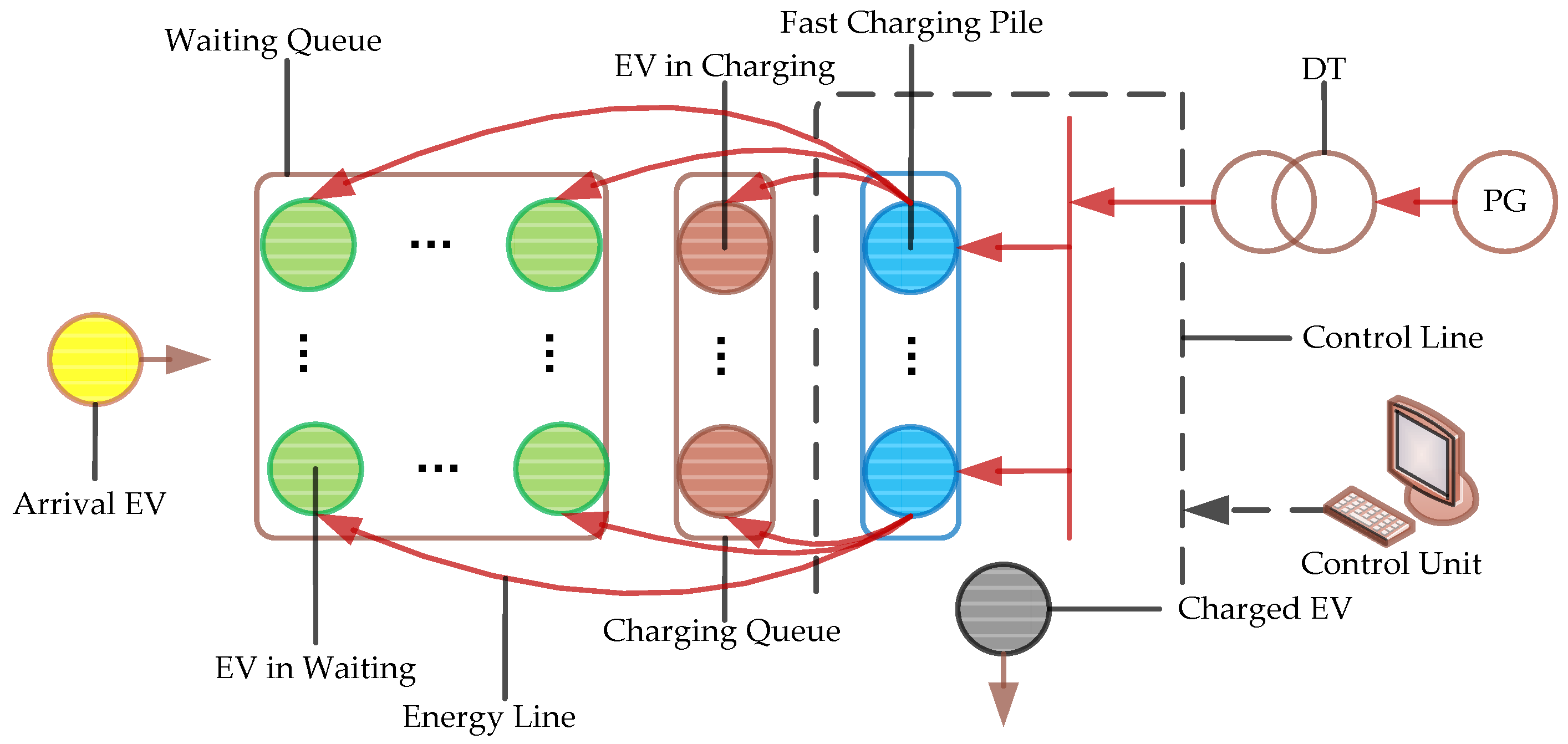


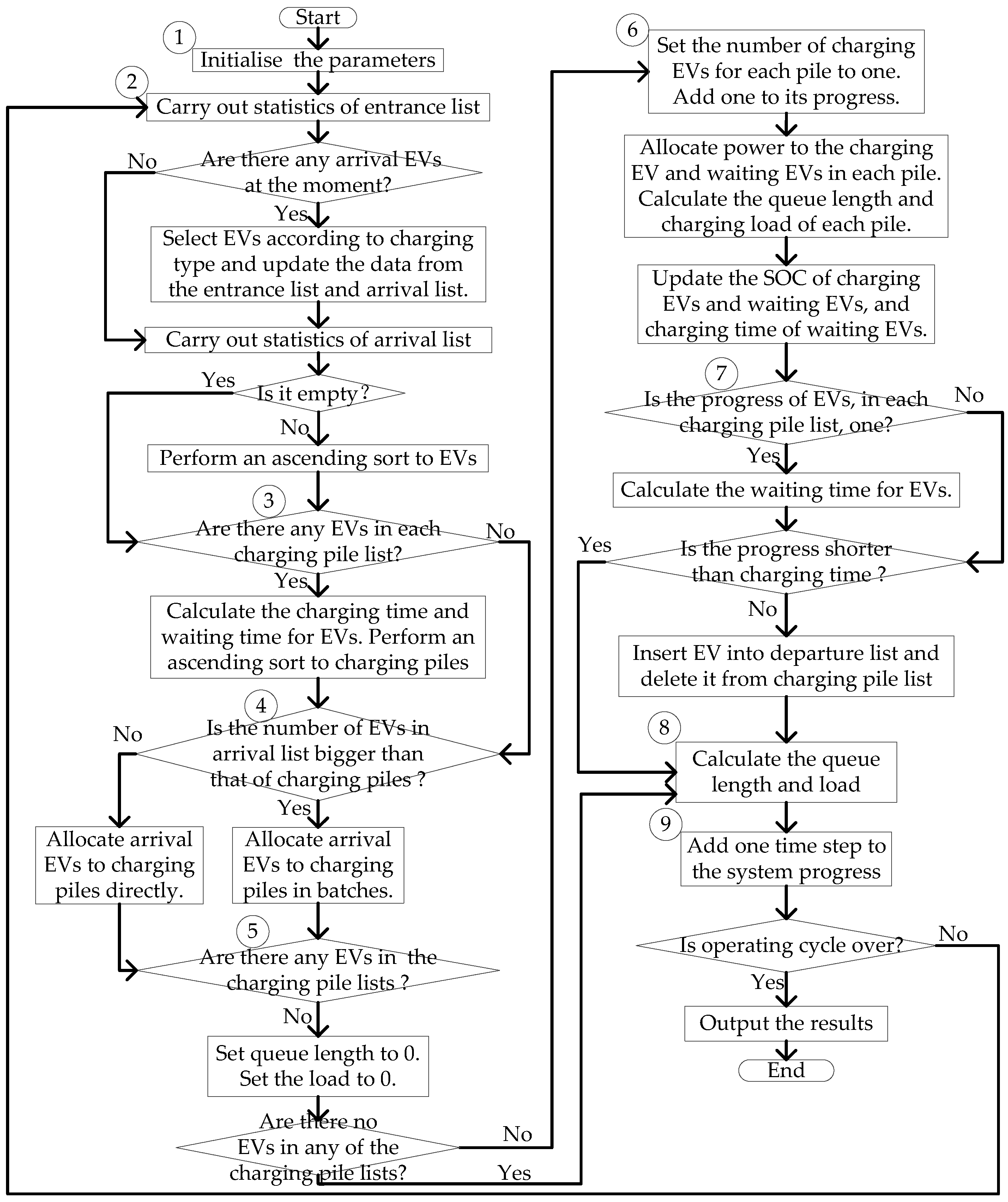
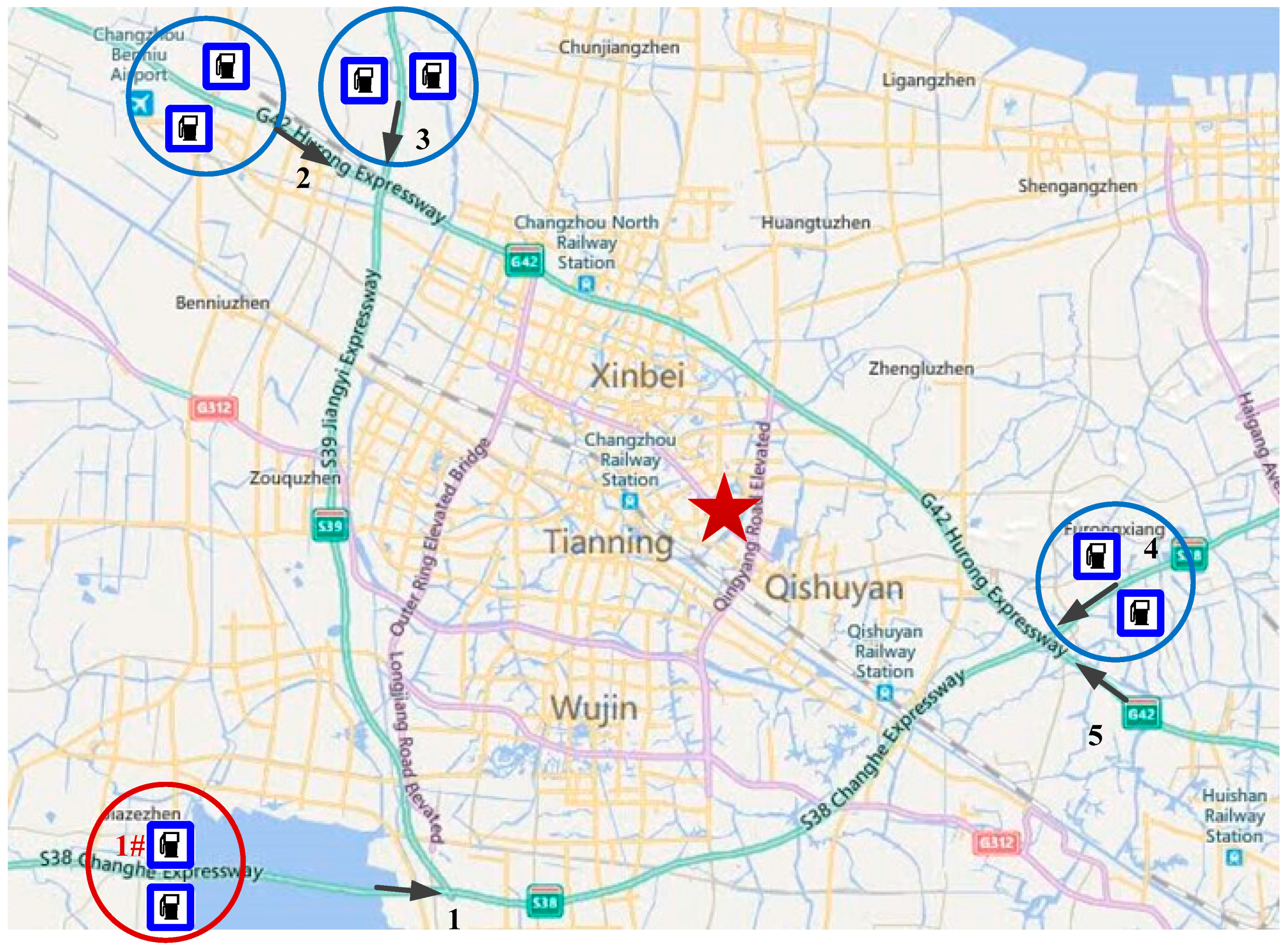
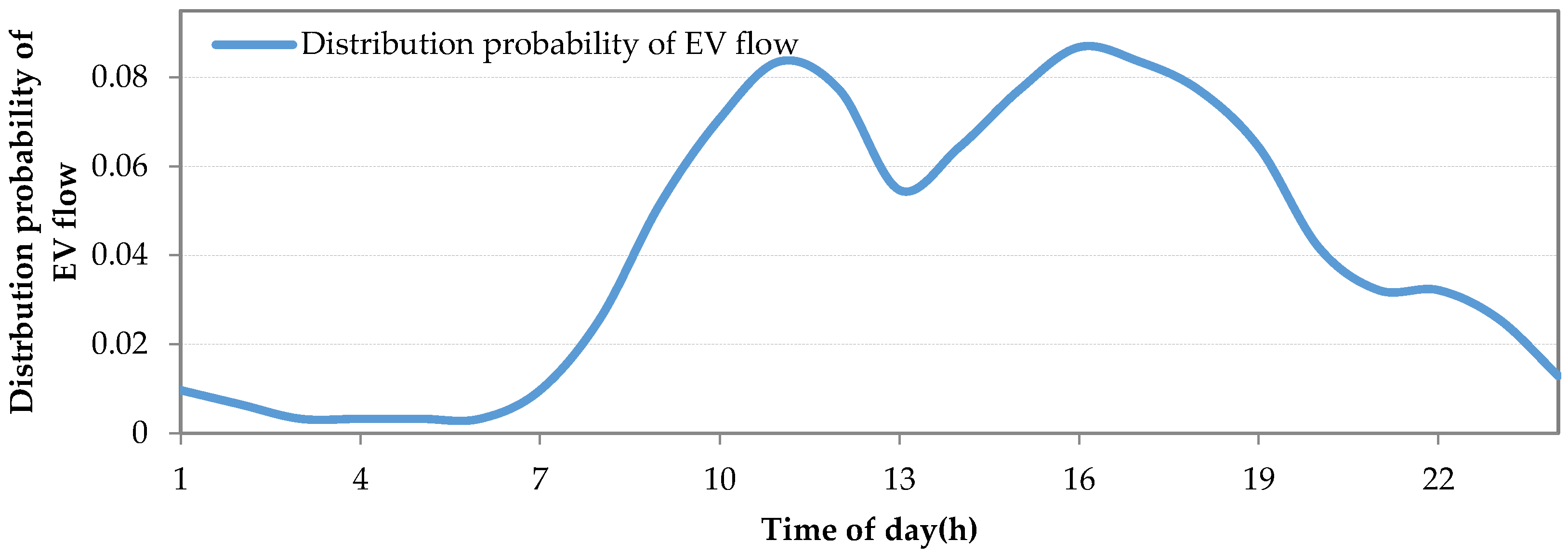


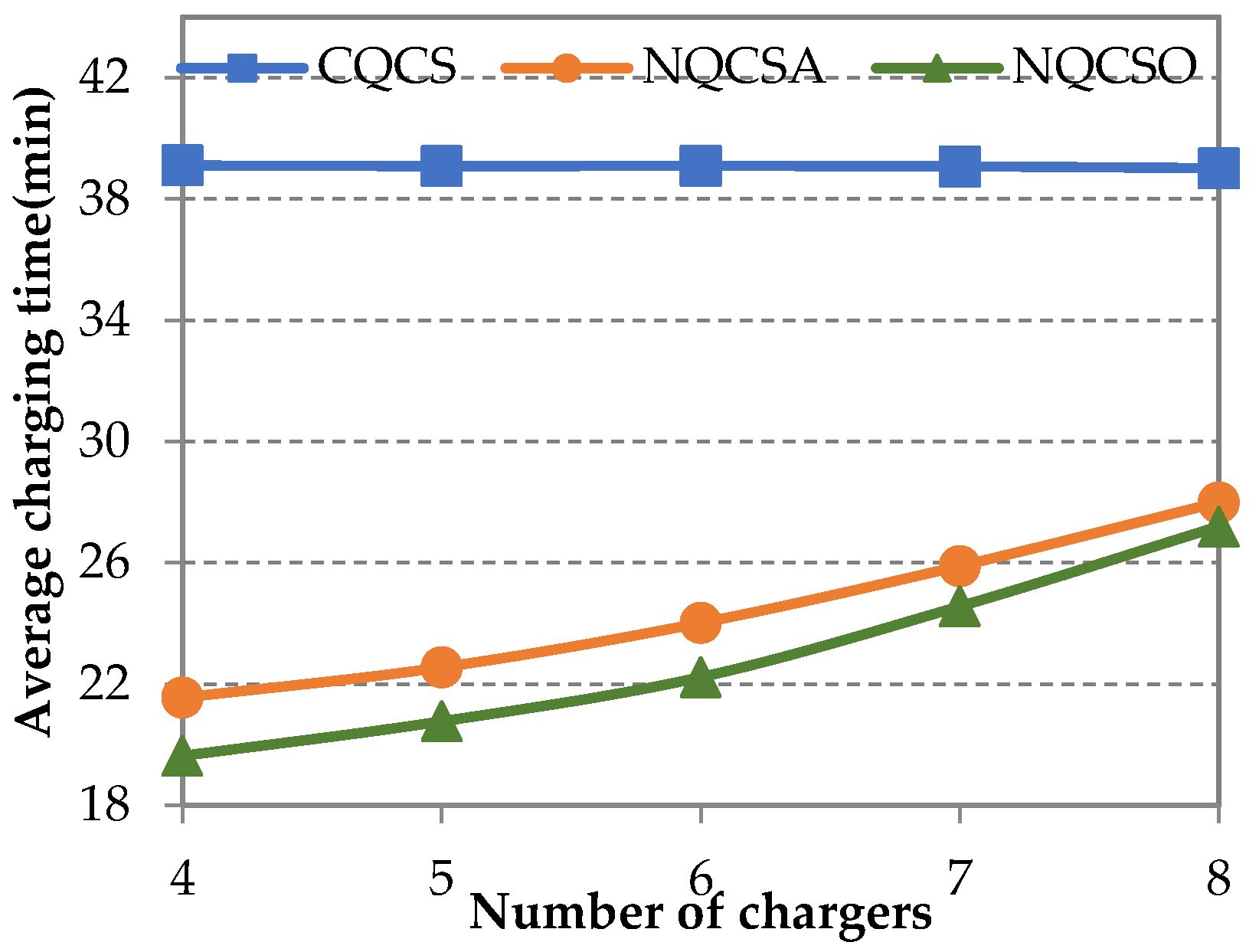
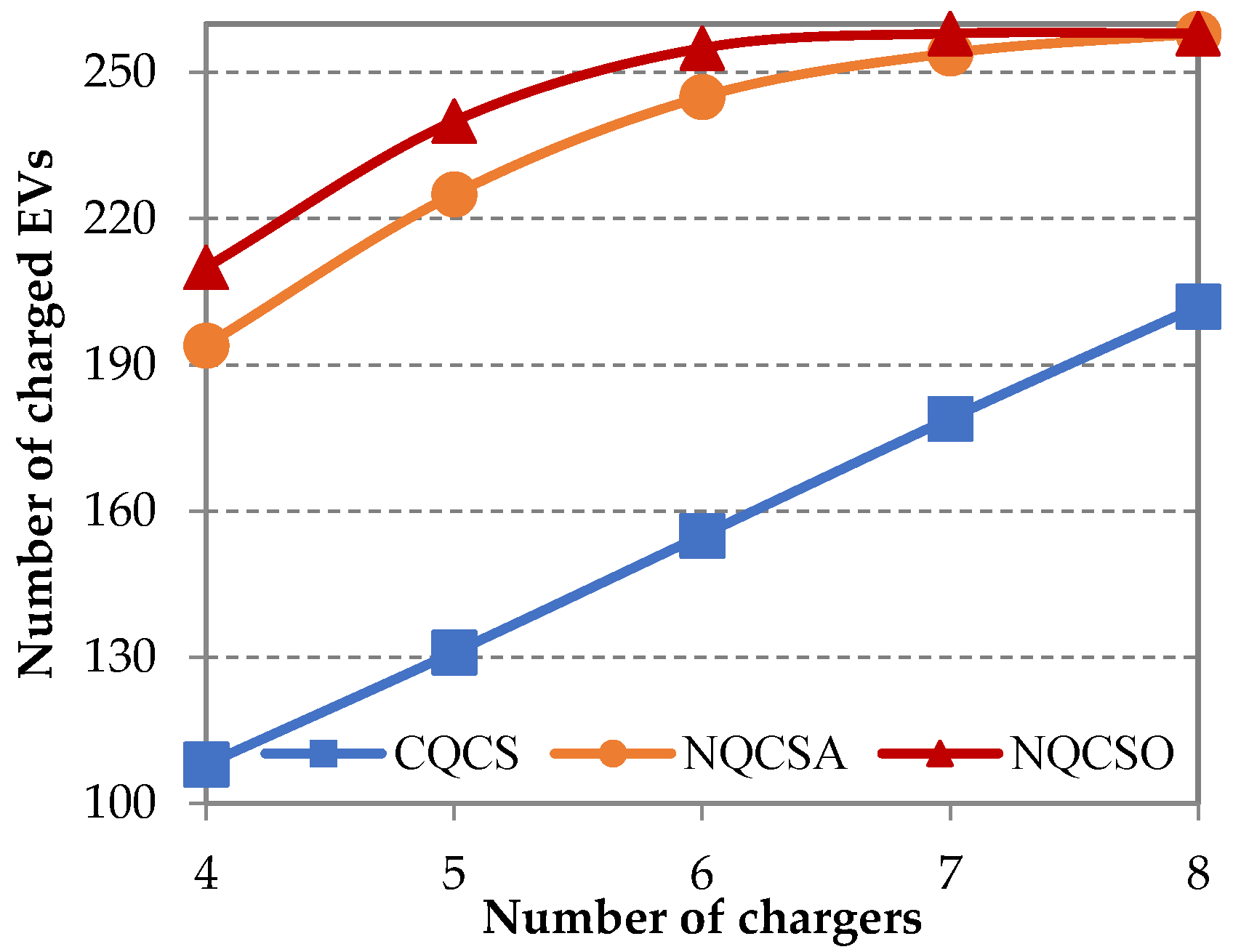
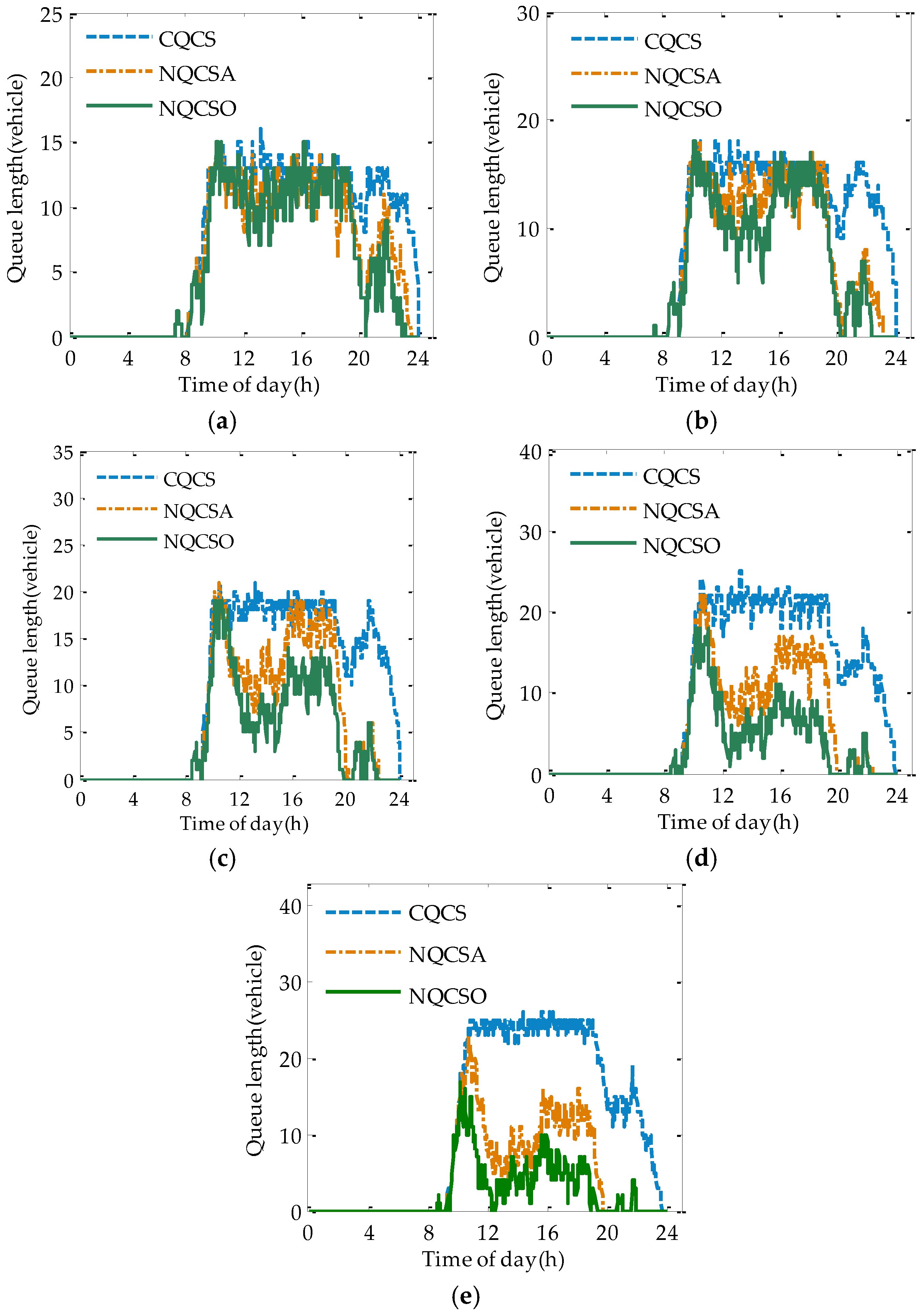
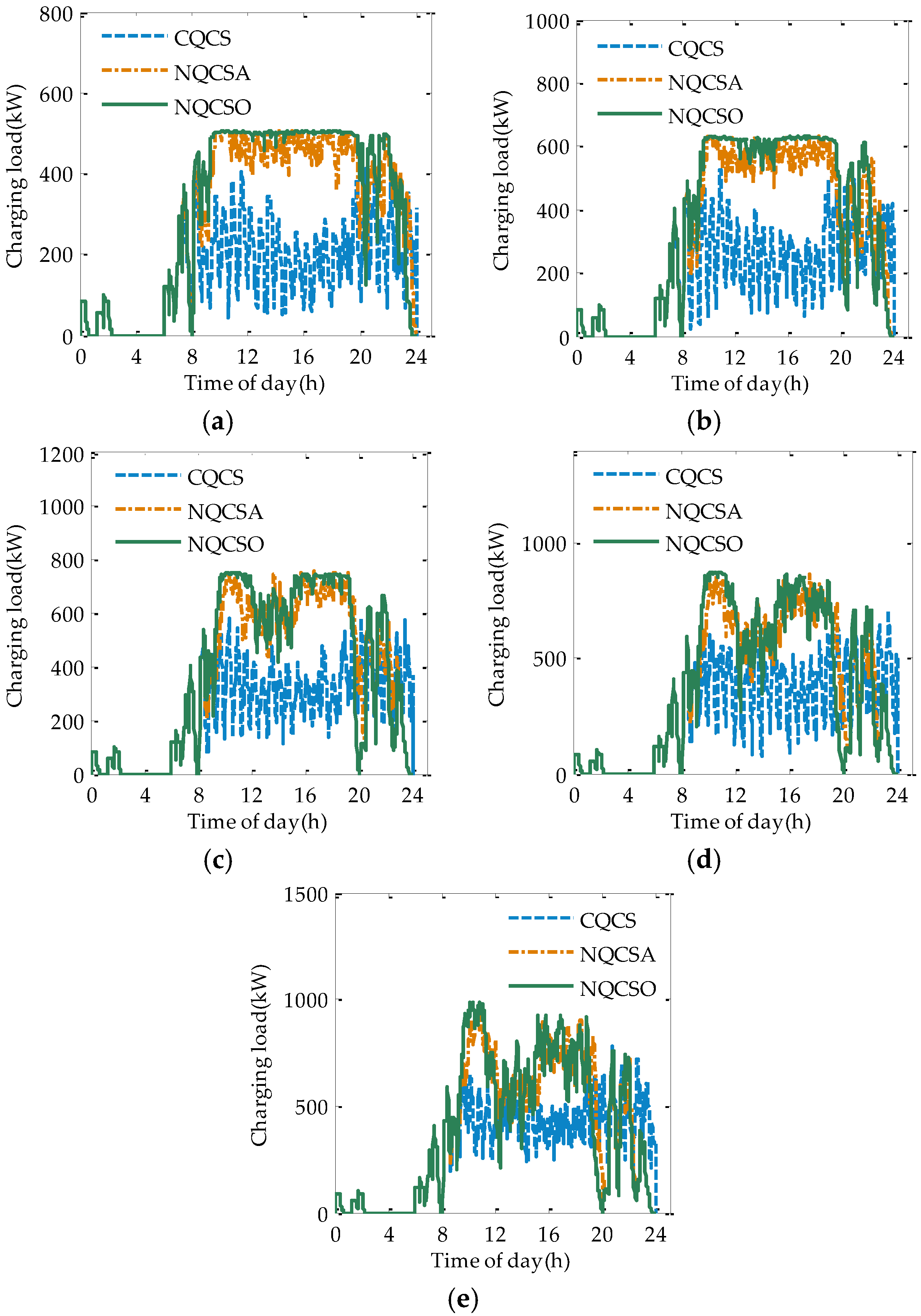
| Period of Time | Year | Traffic Growth Rate |
|---|---|---|
| 1 | 2014–2015 | 5.4% |
| 2 | 2016–2020 | 4.1% |
| 3 | 2021–2025 | 3.1% |
| 4 | 2026–2030 | 2.0% |
| Type | Battery Capacity | Maximum Mileage | V | Charging Power | K |
|---|---|---|---|---|---|
| Oversized EV | 85 kWh | 369.5 km | 70 km/h | 120 kW | 0.692391 |
| Middle-sized EV | 60 kWh | 285.7 km | 90 km/h | 84.7 kW | 0.573061 |
| Small EV | 40 kWh | 200.0 km | 110 km/h | 56.5 kW | 0.646392 |
| Type | Number of Chargers | Output Interfaces | Charging Power Limit | Parking Spaces |
|---|---|---|---|---|
| Conventional CS | 4, 5, 6, 7, 8 | 1 | 126 kW | 16, 20, 24, 28, 32 |
| New CS | 4, 5, 6, 7, 8 | 4 | 126 kW | 16, 20, 24, 28, 32 |
| Number of Chargers | CQCS | NQCSA | NQCSO |
|---|---|---|---|
| 4 | 135.7 | 67.1 | 57.9 |
| 5 | 130.3 | 64.3 | 54.5 |
| 6 | 127.4 | 60.7 | 46.8 |
| 7 | 123.4 | 56.9 | 42.3 |
| 8 | 121.5 | 53.6 | 40.2 |
| Number of Chargers | CQCS | NQCSA | NQCSO |
|---|---|---|---|
| 4 | 0.3096 | 0.5840 | 0.6208 |
| 5 | 0.3090 | 0.5373 | 0.5726 |
| 6 | 0.3146 | 0.4881 | 0.5049 |
| 7 | 0.3080 | 0.4324 | 0.4398 |
| 8 | 0.3039 | 0.3849 | 0.3849 |
| Number of Chargers | CQCS | NQCSA | NQCSO |
|---|---|---|---|
| 4 | 26.2 | 16.5 | 15.2 |
| 5 | 29.2 | 19.2 | 18.0 |
| 6 | 33.7 | 21.8 | 22.5 |
| 7 | 38.2 | 24.3 | 27.8 |
| 8 | 36.8 | 27.0 | 31.9 |
© 2016 by the authors; licensee MDPI, Basel, Switzerland. This article is an open access article distributed under the terms and conditions of the Creative Commons Attribution (CC-BY) license (http://creativecommons.org/licenses/by/4.0/).
Share and Cite
Chen, L.; Huang, X.; Chen, Z.; Jin, L. Study of a New Quick-Charging Strategy for Electric Vehicles in Highway Charging Stations. Energies 2016, 9, 744. https://doi.org/10.3390/en9090744
Chen L, Huang X, Chen Z, Jin L. Study of a New Quick-Charging Strategy for Electric Vehicles in Highway Charging Stations. Energies. 2016; 9(9):744. https://doi.org/10.3390/en9090744
Chicago/Turabian StyleChen, Lixing, Xueliang Huang, Zhong Chen, and Long Jin. 2016. "Study of a New Quick-Charging Strategy for Electric Vehicles in Highway Charging Stations" Energies 9, no. 9: 744. https://doi.org/10.3390/en9090744
APA StyleChen, L., Huang, X., Chen, Z., & Jin, L. (2016). Study of a New Quick-Charging Strategy for Electric Vehicles in Highway Charging Stations. Energies, 9(9), 744. https://doi.org/10.3390/en9090744





